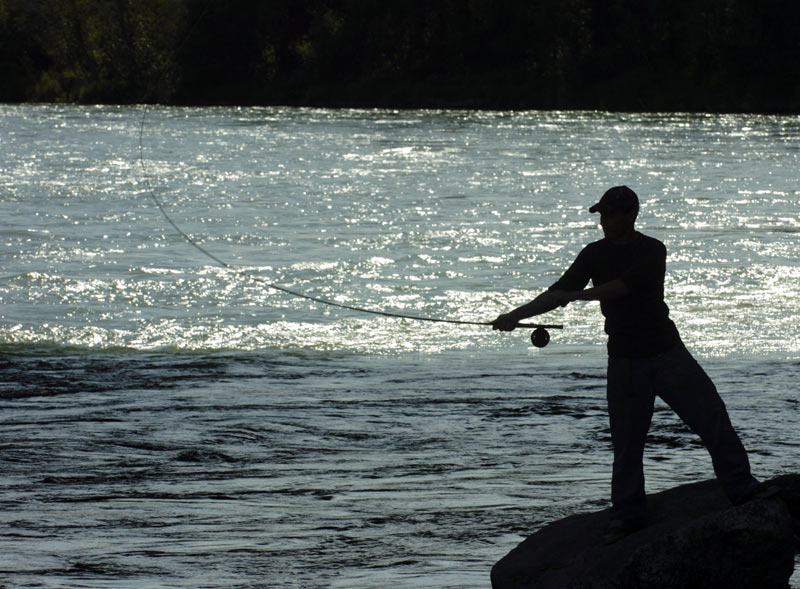If fishing is on your Alaska “to-do” list, but you need a few tips, this is for you.
Guides
An easy way for a visitor to go fishing is with a guide.
A good guide will furnish you with the proper tackle and bait and put you on fish, if possible. Most guides have boats, which give you the advantage of being able to fish more area and more effectively.
Some fish the saltwater, where your prey might be salmon, halibut and other species.
Not having to buy equipment or know anything about fish or fishing is one of the advantages of fishing with a guide.
Guided fishing also is a way to learn a lot in a short time from people who know their business. A guided trip might be the only kind that will fit into a tight schedule. Cost can be a factor in whether you choose to fish with a guide.
When shopping for a guided trip, be sure you’re comparing “apples to apples.” Full-day trips cost more than half-days, “combo” trips more than single-species trips and peak-season trips more than off-season trips. Guided fishing trips in waters on and around the Kenai Peninsula range from about $150 for a half-day of silver fishing on the Kenai River to more than $300 for a full-day combo trip on the ocean for kings and halibut. Guided fly out trips cost even more.
Solo trips
Do-it-yourself fishing has its own rewards. As master of your own fate, you’ll know the joys of discovery and accomplishment. If you’ve never caught a salmon, set your sights on one of the more easily caught species, say, pink salmon. When you’re able to hook and land those, you’re ready to move up to fishing for sockeyes, silvers and even kings.
Gear
Spinning gear makes the best “starter” outfit for salmon fishing in streams. A graphite-composite rod with a medium to medium-heavy action, 7’ to 8’-6” in length, is the choice of most local anglers. The reel should be capable of holding about 200 yards of 15 to 25-pound-test monofilament line. Line is the most important part of the tackle “chain,” so fill the reel with a premium monofilament, such as P-Line, Ande, Maxima or Berkley Trilene-XL.
Knots
Before hitting the water, learn to tie a few knots. For tying on swivels and lures — “terminal” tackle — the Palomar is easy to tie and strong. For fishing with salmon roe, the Egg Loop knot does the trick. (If you’re not up to tying the Egg Loop, pre-tied hooks are available.)
Either the Trilene knot or the Uni-Knot will take care of most other situations. You’ll find instructions for tying these knots at most tackle vendors, in tide books and on the Internet. Sharp hooks catch more fish. You can tell when a hook is sharp by dragging its point across your thumbnail. A sharp hook will scratch and dig in. The most popular lure for kings and silvers is the Spin-N-Glo, usually enhanced with cured salmon roe. For pink and silver salmon in streams, try a size 4 or 5 Vibrax spinner. For sockeyes, the Coho fly is the lure of choice.
Technique
The most popular method of bank fishing for salmon in streams is drift fishing. From shore, cast slightly upstream from straight across and let the current carry your lure downstream.
In streams, salmon usually stay close to the bottom. You should feel your lure or sinker tap ping along the bottom as the current carries it downstream. If you don’t feel anything, put on a heavier sinker. Any unusual hesitation in the drift could be a fish. Quickly set the hook with a fast, upward swing of the rod.
When you hook a fish, keep your rod tip up, and let the rod and reel do the work. Whenever the fish isn’t running, “pump” the rod, cranking the reel only on the downstroke. When the fish is tired, lead it headfirst into a landing net or slide it onto a gravel bar. Finding a place to fish where someone isn’t already fishing can be a problem, but don’t be afraid of crowds. If lots of people are fishing, the fishing is probably good.
Rules
Regulation booklets are available at stores that sell fishing licenses.
The Alaska Department of Fish and Game, 43961 Kalifornsky Beach Road in Soldotna, has free brochures on salmon-run timing and other useful information, such as public fishing areas. Fish and Game has a 24-hour telephone number for sport-fishing info 907-262-2737. Before you go, be sure to read the regulations for the water you’ll be fishing, and know how to properly release a fish, should that become necessary.
Good fishing!
